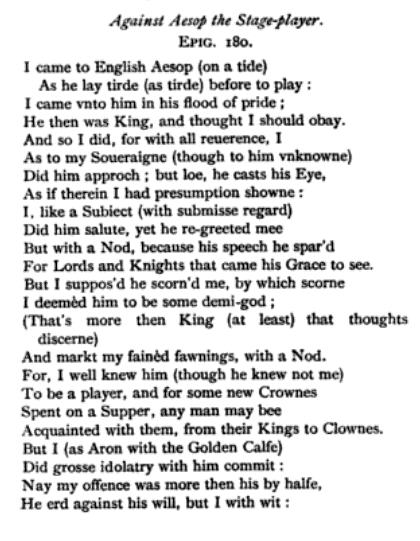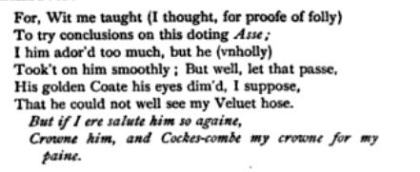A Fabled Pair
I am currently reading, and recommend, Censorship and Interpretation by Annabel Patterson. The book is critical to understanding the climate of censorship in the Tudor and Jacobean periods (and beyond.) It is also insightful on the use of allusion and veiled meanings to circumvent censorship. Patterson argues that modern scholars too often dismiss allusions that were a necesssary form of communication in the period.
Patterson comments on beast fables as one mode of commumincating too-hot topics. In Sydney’s Old Arcadia Geron tells a fable of a swan who was ‘silenced by statute’ by a ‘parliament’ of beasts that were objects of the swan’s social satire. Here’s the fable.
“There was the Swan of dignity deprived,
And statute made he never should have voice:
Since when, I think, he hath in silence lived.”
Patterson sees the Geron’s Swan fable as an allusion to the censorship of John Stubbes, who’s hand was cut off by the authorities for his writings. Geron’s swan fable suggests Jonson was referencing the swan silenced by statute in the First Folio’s “Sweet Swan of Avon” passage. Recall also Shakespeare’s Sonnet LXI “And art made tongue-tied by authority,” as a similar allusion to silence by censorship.
Reading Patterson’s discussion of fables as allusion in Censorship and Interpretation calls to mine the previous post here discussing the character of Æsop the player/politician in Poetaster who informs on Horace and is ultimately whipped. Is Jonson naming Æsop as an allusion to a beast fable applicable to the player? Critics cite the Roman actor Æsop as the model for Jonson’s character, not the Greek fabulist Æsop. Perhaps it could be both? But if there is an allusion to a fable here, which one? There are hundreds of Æsop’s Fables to choose from.
Jonson’s Æsop the player is not the only contemporary reference to a player of that name at that time. John Davies of Hereford included an epigram Against Æsop the Stage-player in his Scourge of Folly, 1610. Here’s the entire epigram.
Sabrina Feldman discusses this epigram in her book, The Apocryphal William Shakespeare. She argues that AEsop is the player, Shaksper, which is consistent with our evidence of AEsop from Poetaster. Her discussion of John Davies’ epigram to Aesop is here.
Between the two Æsops, Jonson’s and Davies’, can we locate a fable appropriate to both?
Æsop the player in Scourge of Folly is an Asse.
Æsop the player in Poetaster is whipped.
Is there a beast fable where an ass is whipped?
You knew there was, didn’t you?
An ass and an ox had been yoked together to pull a single load. The ox was making a great effort, even though he had an injury to his horn, while the ass was doing nothing to help. As the ox struggled to pull the load by himself, he soon died. The driver then loaded the ox’s carcass upon the ass and began beating him mercilessly. The ass broke down and collapsed under the weight, dropping dead in the middle of the road. A flock of birds flew up and alighted on the ass’ carcass. ‘If only you had been kind enough to help the ox pull the load,’ they said, ‘you would not have died this untimely death, with carrion birds feasting on your flesh.’
Here’s the latin text from Ademar
Asellus et Bos uno sociati iugo trahebant. Bos dum conatur paulo ualidius incedere aegro cornu, Asellus ipse negabat (n)ullum leuamen accipere. Solus a[ra]t[ru]m [trahens] Bos cornu [corruit], et confestim mortuus est. Asinum Bobulcus carne Bouis exaggerat. Qui multas inter plagas ruptus cecidit, et expirauit media [uia] pondere colllapsus. Tua (sic pro Tunc) Volucres aduenientes ad praedam conuolant, dicentes : Si te precanti mitem exhibuisses Boui, non iam inmaturo nos interita pasceres tuo.
Iugo – meaning yoked, coupled, joined. The Ass and the Ox (Oxford) together. Diligent readers of Rambler’s blog have encountered over and over the dual nature of the Vere and Shaksper, seemingly interchangeable, across so many contemporary works. That coupling has been a theme of this blog as well. I’ll explore at another time this fable further, what it might be telling us of the circumstances between the ox and the ass. The identification of Shaksper as an ass begs us to investigate Jonson’s later play, The Devil is an Ass as well. That work is on the agenda, but I’m not through with Poetaster just yet.
more anon.
October 19, 2014 No Comments



